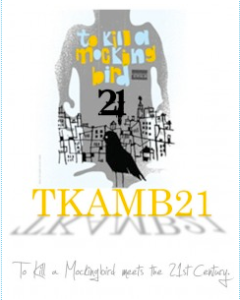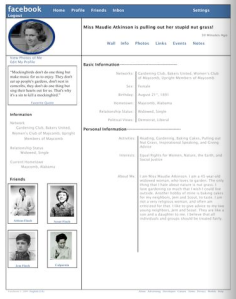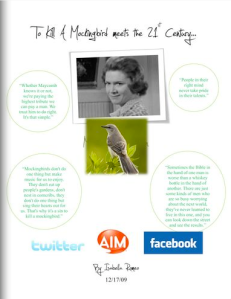Yesterday, Silvia Tolisano of Langwitches Blog (The Magic of Learning) shared an incredible story of learning. After reading through her post I asked if I could share the story here and she graciously agreed. Siliva and the fifth grade teacher she worked with did an incredible job of letting her students take charge of their learning. It has been so successful that her students want to continue learning and connecting their knowledge about Christopher Columbus. I love that Silvia’s story of learning begins with a glimpse of what the planning for the learning looked like. Silvia lets us peek inside the intentional planning and organizing of the learning. Using an iPad and the iThoughtsHD app, Silvia and the fifth grade teacher planned a unit on Christopher Columbus that went beyond the textbook and exposed them to authentic research, multiple perspectives, and the opportunity to come up with their own conclusions about the “hero” status of Christopher Columbus in the United States. The results are truly incredible. Follow this story of learning from the planning stages to the “end” where students find themselves eager to continue their learning.
Christopher Columbus Creates 21st Century Explorers
By Silvia Tolisano Langwitches Blog
(Reposted with permission)
Take a listen to the students’ “CC Newscast” video and then read on about the “upgrade” process from textbook to globally connected learning!
http://vimeo.com/moogaloop.swf?clip_id=16175433&server=vimeo.com&show_title=1&show_byline=1&show_portrait=1&color=00ADEF&fullscreen=1&autoplay=0&loop=0
Columbus Creates 21st Century Explorers from langwitches on Vimeo.
Christopher Columbus Creates 21st Century Explorers
It all started out with a planning meeting with the 5th grade teacher. We used iThoughtsHD on the iPad to brainstorm and sketch out some of our ideas for the unit. The visual helped us see the big picture and made it easy to add components in areas that we felt needed upgrades in terms of 21st century skills and literacy. We wanted to give students research opportunities that went beyond their textbook and library. We wanted them to be exposed to multiple perspectives and come up with their own conclusion about the historical figure “celebrated” here in the USA on October 12th of every year.

Christopher Columbus Unit Plan
We had a meeting with students to talk about the Christopher Columbus unit. Collaboratively we created a KWL (Know, Want to Know, Learned) chart on the iPad and got them thinking about THEIR contribution to the research about the historic figure. We decided that the culminating project and assessment would be a class movie. Each student would contribute a segment with their research findings. The segment could be a presentation, dance, song, etc. Mrs. Z, their teacher created a Google Doc, which she shared with all her students. After thinking and negotiating project partners, they added their contribution ideas to the document. Some students needed more help than others form their teacher. Using Google Docs as a class community greatly contributed to the collaborative nature of the learning taking place.
- Jilliyn- Skype with people Mrs. Tolisano has made contact with in other countries.
- Shira-”Skype Team”-when we interview students from other countries about what they learn about Columbus. You must research first about the other country and then formulate your questions for the interview.
- Josh-research statistics about Columbus’s voyages-how many sailors were on board, etc. and formulate questions to ask when we interview people about Columbus and interview Ms.Stein.
- Edyn-perform a play about Columbus. Either write your own play based on research you do on Columbus or check with Mrs. Tolisano -she has a play you can use.
- I think it would be good if you had commentators to speak after you do your play. They would decide whether your performance was mostly fact or fiction based on research yes
- Hannah-Dance-BUT-you must also create a song about Columbus based on research about his life. Interview Mrs. Tolisano.
- Ryan-research and see if any movies and/or video games have been made about Columbus–Maybe check educational channels too such as Discovery and PBS and try to view the programs (with your parents or my approval first)
- Allie- I will interview Mrs. Rogo. about Christopher Columbus, be in a play and make a Power Point about important dates in Christopher Columbus’ life.
- Sabrina- Find books about Christopher C. and see how the authors portray him and interview Mrs. Rogo–must submit interview questions to me for approval first and you will need someone to film the interview with the flip camera. Also-did you want to perform in the play?
- Max-videographer…commentator/fact checker
- Daniel-I know you are interested in dates…so you will research and make a timeline of Columbus’s life. Include at least ten important dates.
- Rachel-Why did Christopher Columbus take his journey? What happened to the prisoners after the journey? How hard did he work during his journey? You must research several sources to find you answers and TELL me what sources you used.
- Montgomery-research why Columbus decided it would be a good idea to sail West and not East.
- Lance-I would like for you to interview Mrs. Reppert and ask her questions about Columbus. You will need to do some research so you will know what you want to ask before your interview. I will need to approve your questions first. You will also need someone to film with the flip camera.
- Samuel-I would like for you to meet with Mrs. Leonard and email the contact she found. (I will give you her name) I want you to tell her what our class is doing (our Christopher Columbus project) and ask her at least five questions. You will discuss this on the video. Sam and Josh z will do special effects on video.
- Claire–skype interviewer and help Rachel
- Shelby-see Edyn’s name
- Reesa- I will make a song and dance with hannah
- Josh-you will do research about Columbus’ s voyages. You will tell us where he went on each of his four voyages.

Class Meeting
KWL Chart created with and by the students. Again, using iThoughts we passed the iPad around the table and asked students to add a bubble to the chart. We will later re-visited the chart to add WHAT they have learned about Christopher Columbus.

KWL- Student Chart
I blogged and tweeted a call for “experts” who would be willing to be contacted by our students and interviewed about their knowledge and perspectives of Christopher Columbus.
Our school’s librarian was also able to pass on an e-mail contact of a Native American from her network.

Call for “Experts” willing to share knowledge and perspective
Greta Sandler from Argentina and Melissa Techman from Virginia responded via Twitter, Maryna Tsehelska from the Ukraine and Steve Wilmarth from China answered our calls through the Around the World with 80 Schools site.
In an effort to support our students as collaboration and communication coordinators, we passed the task to e-mail and communicate with the “Experts” on to them. I met with the students to create a draft for their initial contact e-mail. They took it from there to coordinate Skype calls.

Student e-mail to Skype Contact

Skype with Argentina

Mrs. Techman read a book via Skype to the class

Skype Call with the Ukraine
Other students eagerly got started in preparing their contribution to our collaborative project.

Enthusiastic E-mail from Students
Then came the moment when the class formulated questions to be used in a survey asking others to share their thoughts, ideas and knowledge about Christopher Columbus. The survey was then embedded on the classroom blog. I tweeted and blogged about their survey and asked my network to please take the time to answer their questions.

These were the questions:
- Where do you live?
- How old are you?
- Do you think Christopher Columbus was a Hero, Victim or Villain?
- Explain your answer
- Do you think Christopher Columbus discovered America?

Survey embedded on Classroom Blog
The survey generated just short of 400 entries from over 12 countries! Students were enthralled when we projected the survey spreadsheet and the entries were “falling” in as they were watching! We shared the Google Document with all the students, so they would have access to it anytime.

How exciting as the survey responses were being updated live on the spreadsheet
As a class we analyzed the responses of the survey in the spreadsheet, although I received nightly updates via email from excited students as the numbers of participants climbed steadily.

Analyzing the Survey
The following Wordles were created with the answers for some of the questions.

Location of Survey Contributors

Survey: Do you believe Columbus discovered America?

Survey: Do you believe Columbus was a Hero, Villain or a Victim?
You can download the survey entries as a pdf file here.
Once students completed their research, we started working on the Newscast video, which would be the collaborative product of our learning.

Newscast Brainstorming Session

How will each section be recorded?
We were also contacted by Steve Wilmarth, who is currently teaching in Wuhan, China at a Middle School Attached to HuaZhong Normal University.
He writes:
I would love to have my students in China join in the discussion about Christopher Columbus. They would like to share with your students the story of the great Chinese admiral, Zheng He (http://en.wikipedia.org/wiki/Zheng_He), and his exploration of the world 50 years before Columbus set sail.
My students are studying US history this semester, and we are exploring the topic of the “Columbian exchange;” how the the early explorations brought plants, animals, and diseases around the world for the first time.
What an incredible opportunity to connect with these Chinese High School students with our 5th graders. Learn about the exploration in Asia. Although Christopher Columbus day as come and gone and the 5th graders unit on the historical figure has (officially) ended, we will continue to make connections to expand our horizons and learn from different perspectives.
Learning can be sooo exciting!!! What kind of tried and tested project, unit or lesson plan have you upgraded recently? Please share your documentation or reflection of the upgrade to help build examples from the classroom HOW teaching and learning are taking on new forms.
Thank you Silvia for sharing this story of learning. It is refreshing to see the ways that technology can be used to connect and empower students in their learning! If you have a story of learning you would like to share, let me know about it via my contact page.
Collaboration, History, Inquiry, Literacy, Research, Social Studies
21st century learning, christopher columbus, education, hero, history, langwitches, learning, research, silvia, technology, united states























